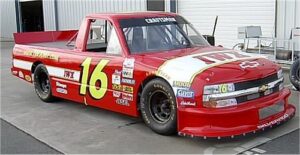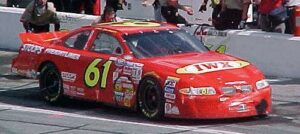Before we jump into the story of what happened, it is necessary to provide some background information about a previously very successful small team. The focus here is on Xpress Motorsports, a major player in NASCAR’s lower divisions in the late 90’s and early 2000’s. The team met their demise following some unfortunate issues after a Busch Series (Xfinity Series) race in 2001, which is where this article will focus.
Beginnings (NASCAR Craftsman Truck Series):
Formed in 1996, IWX Motor Freight owner Steve Coulter originally formed Xpress Motorsports to promote his brand, hiring relative Truck Series veteran Randy Tolsma to drive his #61 IWX Motor Freight Chevrolet Silverado. Tolsma attempted two races late into the 1996 season at Phoenix and Las Vegas. While the team DNQ’d in their last attempt at Las Vegas, Tolsma did qualify for race 23 in Phoenix, finishing 29th.

The team experienced many years of success following their 1996 debut. Tolsma would run for the team through the 1998 season, joining Impact Motorsports to drive their #25 Dodge in 1999. Following Tolsma, the newly-badged #16 Chevrolet would be at the front of the pack often, winning two straight series championships in 2002 and 2003 (with Mike Bliss and Travis Kvapil respectively).
NASCAR Busch Series (1998-2001):
1998: The immediate success of the Truck Series program led Coulter and Xpress Motorsports to a part time schedule in the Busch Series from 1998 through 2001. At the tail end of the 1998 season, veteran Cup Series driver Derrike Cope was hired to drive the #61 IWX Motor Freight Pontiac at Atlanta. This was an inauspicious debut for the team, as they would come home 36th after an engine failure.
1999: The 1999 season saw Cope return to the #61 Pontiac for the first 3 races of the season, with then rookie Tony Roper assuming driving duties for the next 16 races. Roper would collect three Top 10 finishes for the team, before departing after race 24 at Gateway.
Following Roper’s departure, veteran drivers Robert Pressley, Stanton Barrett, and Morgan Shepherd would finish the season. Shepherd nabbed the team their 4th Top 10 of the year, finishing 10th at Rockingham.
2000: Yet again hiring a veteran Cup driver to wheel the #61, journeyman Hut Stricklin was hired for the 2000 season. Stricklin made an immediate impact with the team, qualifying on the pole in the season opener at Daytona, but failed to qualify for race 2 in Rockingham. Stricklin would also earn the team two other Top 10 finishes before departing after race 10 in California.

The team returned 3 races later in Charlotte, in a one off deal with Darrell Lanigan, before hiring up and coming rookie Tim Sauter to pilot the #61 towards the end of the year. While Sauter missed two races, he would make the final 3 races of the season, with a best of 15th in the finale at Homestead. Sauter also brought some financial backing, as Stoops Freightliner would join the team heading into 2001.
2001: Sauter returned for the 2001 season, vying for rookie of the year behind the #61 Stoops Freightliner Chevrolet (Pontiac on superspeedways). Sauter showed great promise throughout the beginning of the season, immediately scoring a 10th in Daytona. Sauter would continue to have a decent rookie season for this time, scoring another Top 10 and having several Top 20 runs going into race 16 in Kentucky. Kentucky however, is where events took an ugly turn, with a severe penalty issued to the team for a rules-violation.
2001 Outback Steakhouse 300 (Kentucky Speedway):
Sauter would qualify a decent 14th for the race, but would get into an accident on lap 169. This accident would be the catalyst for the penalty mentioned above, as NASCAR had taken #61 to a thorough inspection process post-accident. What was discovered, is that the the roll cage bars had been lightened, and had several placed holes drilled into them. Despite the objections of then crew chief David Fuge that these modifications fell into a “grey area” in the rulebook at that time, the massive penalty was upheld. In theory, these holes would lighten the weight of the 61, giving the car a speed advantage.
The penalty(s):
- Owner Steve Coulter was docked 60 car owner points
- Driver Tim Sauter docked 60 points, relegated to a 43rd place finish, costing an additional 39 points with the position drop.
- Crew Chief David Fuge indefinitely suspended, fined $30,000 dollars.
The Aftermath:
In late June 2001, owner Steve Coulter announced that the Busch Series team was folding post penalty, and all equipment was being sold. Being a smaller budget team, such a penalty was disastrous economically for Coulter. David Fuge, who was left with the unenviable task of handling the team’s sale of equipment and parts, would try to appeal the penalty in July, but it was to no avail.
Driver Sauter was able to salvage an end to his season, by running the last two racing of the season in AP Performance Racing’s #19 Chevrolet. Sauter also returned to the series full-time in 2002, driving the 19.


